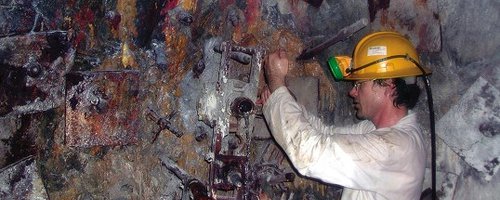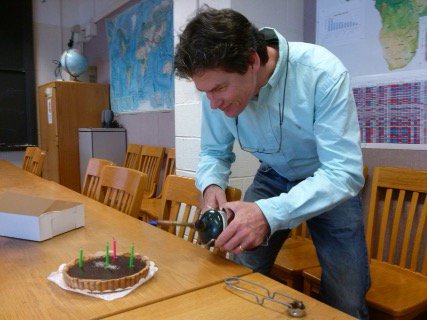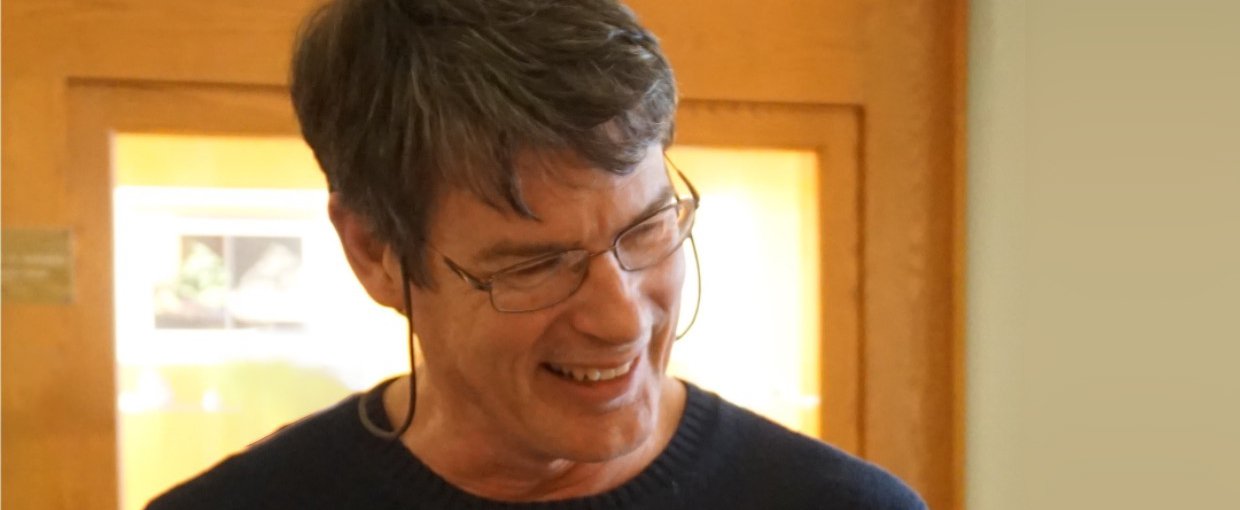Written byCompiled by Rick Colwell, Karen G. Lloyd, and Lisa Pratt

As our lovely planet again swung around its star this fall, we lost an extraordinary leader, provocative colleague, and dear friend Tullis C. Onstott at the far-too-early age of 66. His scientific impact was immense. His passing leaves a gaping hole in numerous active projects and reminds us the wealth of ideas and impact of relationships he created among us.
A first interaction with TC often occurred attending a talk he gave or discussing unusual data he saw on your poster. He engaged irresistibly with lucid presentations of unexpected findings, innovative experimental methods, quantification of metabolic resources, and aseptic sampling under daunting field conditions. He asked tough questions about research conduct and poked at conclusions, often followed by a long pause and then the one word “intriguing…” to indicate his genuine interest in the ideas presented by a student or colleague. His spontaneous, exuberant laugh let you know he was open to your thoughts and eager for collaboration.

Tullis Onstott of Princeton University opens a borehole in a section of rock wall in a South African mine.Image credit: Lisa M. Pratt / The Trustees of Indiana University / NASA / National Science Foundation.
A professor of geosciences at Princeton University, TC was instrumental in establishing the field of deep subsurface microbiology. His inimitable perspective was a blend of geological, geochemical, and biological insights which opened new horizons in the study of life in Earth’s extreme environments and the possibilities for finding similar biogeochemical systems beyond Earth. His research domain cut a wide horizontal and vertical swath on Earth, from both Poles to deep underground. TC perceived that the survival of a microbe could be tracked through geologic time as it was crushed and heated in deep sedimentary rocks and that access to deep mines allowed scientists to walk – or crawl – right up to freshly excavated or drilled underground rock and take samples. He grasped the extraordinary possibility of microbes surviving on chemical energy released by earthquakes or natural radiolytic splitting of water molecules.
His former post-doc, Duane Moser, writes, “The entire field of Astrobiology, of which TC was a founding father, exists to contemplate the possibility of exotic ecosystems on other planets. Given the degree to which Earth’s deep life is physically and conceptually divorced from the known biosphere, deep, rock-hosted life could perhaps be regarded as the first discovery of life on another planet, a planet within our planet; a model for potential life on other rocky planets wherever they may be found.”
From his recent Ph.D. student Rachel Harris, “TC’s passion for the deep biosphere has fundamentally changed our understanding of habitability. His many discoveries – including a single-species ecosystem of Desulforudis audaxviator and Halicephalobus mephisto, the deepest-dwelling animal in the world – have demonstrated how science fact is often stranger than science fiction. TC’s trailblazing spirit has proven that the rock beneath our feet is not sterile as once thought, but rather home to 90% of the Earth’s microbial biomass. I believe of TC’s greatest legacies will be his impact on the astrobiology search strategy, updated in 2018 by the National Academies with the key take-home message to “Go Deep” in the search for life elsewhere in the Universe. We have yet to see the real Mars Underground, but in taking his students and colleagues miles underground across the globe, TC certainly brought us to the next best thing.”
TC made friends and colleagues all around the world, and may be most remembered for his role in the discovery of Desulforudis audaxviator, that lives in a world devoid of solar input, kilometers deep into the Witwatersrand formation in South Africa. His colleague Tom Kieft sums up TC’s impact on his scientific field as, “The obvious direct impact of TC’s research is to reveal the vastness of deep subsurface H2-based microbial ecosystems, but I think an even better way to look at TC’s legacy is to consider the incredible number of people from diverse backgrounds whom he brought together. TC’s approach to science was always collaborative and inclusive, which is a wonderful example for others, including all the students and early career scientists whom he mentored. If all these colleagues follow his lead, then it can change the way science is conducted.”

TC Onstott at the PhD defense celebration for his student, Cara Magnabosco.Image credit: Courtesy of Rick Colwell, Karen G. Lloyd, and Lisa Pratt.
To illustrate how important he was, not just to the science, but to the people who conduct it, here are some thoughts from a small subset of his colleagues. This is not an exhaustive list. There are many more people and many more stories than this.
Former Ph.D. student, Brian Mailloux, says TC was, “always ready to help or with a laugh. Now if you want to get TC’s attention to see or read this presentation, make sure it has an old movie (western) or science fiction quote.”
Renxing Liang, a recent post-doc, said, “I particularly admire TC’s optimism, curiosity and perseverance in pursing science.”
His colleague Jim Fredrickson, writes, “In my opinion TC’s impact was bringing a fresh geosciences perspective, with an emphasis on geochronology to constrain the residence and transport times of organisms and materials, to terrestrial subsurface microbiology and biogeochemistry.”
From his colleague Will Maze, “Three of us who entered the department in 1976, Tullis, Jim Kellogg, and I, had the bond of being fellow students and doing field work in Venezuela for our theses. So not only did I learn a lot about magnetism, paleomagnetism, lasers, Argon/Argon, and more from Tullis, I have a number of memories of more than science. For instance, on a departmental field trip early in our Princeton studies, riding for hours in the back of a van, Tullis performed the entire rock opera Jesus Christ Superstar with accompanying instrumentals. More than an hour from start to finish. Quite the performance!”
From former Ph.D. student, Cara Magnabosco: “As a mentor, TC always gave the right balance of challenge and support. He led by example —- never afraid to step into a different field to learn the right tools for his research. The problem-driven curiosity led him to the South African subsurface to determine how long life can survive, isolated from the surface. Through this research program, TC has shown us the size and extent of the deep biosphere, how subsurface chemolithoautotrophs utilize electron donors and acceptors generated through radiolytic reactions, single-species ecosystems, complex subsurface food webs and rates of subsurface microbial and nutrient turnover. This research has reshaped how we think about life on Earth and the potential for life on other worlds.”
From colleague Anna-Louise Reysenbach: “I will always remember his laugh, over-the-top optimism and positive energy.”
From former post-doc Yuheng Chen: “TC was always very kind to the people around him. He remembered the birthday of his group members and always lighted the candle of the cakes for us. TC was lucky to pursue his most-loved science for all his life until he rests in peace, and I am also very lucky to have been working with such a great mentor for a long time.”

TC Onstott, celebrating the birthday of one of his lab members.Image credit: Courtesy of Rick Colwell, Karen G. Lloyd, and Lisa Pratt.
From former post-doc Maggie Lau Vetter: “I could not ask for more from a mentor. TC demonstrated admirable and contagious character in the pursuit of a science career and in life. With special vision, he saw deeply into scientific problems and research gaps; he humbly reached out to people who had relevant skills and knowledge, and brought them into new areas. He encouraged junior scientists to venture into the unknown, and when possible, walked alongside them; he cared for individuals, near or far. I am forever thankful for TC’s mentorship and friendship.”
From colleague Tatiana Vishnivetskaya: “TC’s passion for the permafrost and astrobiology research was captivating. Those projects range from finding the live microbes in kilometer deep sub-permafrost environment to uncovering extant microbial communities in million years old permafrost sediments to testing permafrost bacteria for their ability to survive in Martian conditions. TC inspired me in many ways, and I was always impressed by his interest and readiness to learn different languages. I am grateful I had a chance to work with TC.”
And, finally, we will finish with the eloquence of Duane Moser, who writes, “TC was that rare individual who successfully navigated the space between scientific disciplines, bringing people and concepts together in new ways to illuminate profound facts about our planet that otherwise might have never been realized. Assembling clues from disciplines that rarely overlap, he was among a small group of pioneers who guided generations of scientists towards the inevitable recognition of a cryptic biome that persists over geologic time scales, unseen within vast inner space of continents. This formerly unrecognized rock-hosted biome within fractured rock aquifers comprises, by volume, one of the largest ecosystems on Earth. TC was probably the first to clearly see this microbial Jurassic Park; disconnected from the entirety of traditional biology, plodding along beneath our cities and politics, utterly indifferent to familiar perceptions of time; where seasons, ice ages, and even the continents themselves come and go without notice or consequence.
He had a gentle intensity that pulled others along in his slip stream. He helped those around him be their best selves through a combination of elevated expectations, that he was more than happy to share, and through leading by example. He was a friend to most, and as they say, never met a stranger. He surrounded himself with the most amazing collective of characters and just being part of this orbit was a gift to those who found themselves within it.”
And so, we say goodbye to TCO with whom some of us traveled deeply underground and broadly across our planet’s surface to discover where life has secured itself in tropical and polar places. Beyond exploring where Earth’s tiny life forms exist, he conceived of how it was confined, how it might be liberated, where it could breathe, however harsh the setting. He went to these places in person and promoted our collective imaginings of the extent of Life on Earth. And this naturally moved him toward predictions of life’s solutions to the challenges of on other planetary bodies. He did all of this with humility, humor, and quiet concentration that spoke of native wisdom. Undoubtedly, he was, like one of the microbes he helped to discover, a bold traveler. And a friend.
